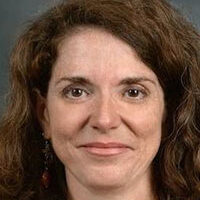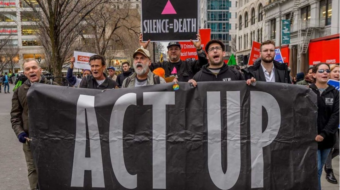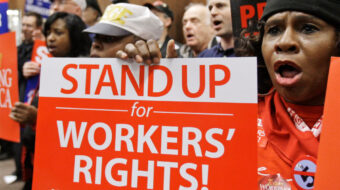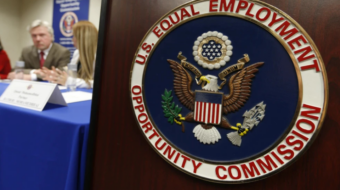
FERGUSON, Mo. – As nighttime fell Tuesday on this St. Louis suburb of 21,000 residents, squad cars began to block the streets leading to the neighborhood where an unarmed black teenager was shot to death by a white police officer, Aug. 9. Anyone wanting to participate in the nightly protests had to park their car in a nearby Save-A-Lot parking lot and walk the mile or so down W. Florissant Ave. to Canfield Dr., the residential street where 18-year-old and soon to be college freshman Michael Brown was killed by Ferguson police officer Darren Wilson.
Passing stores and restaurants, boarded up windows were juxtaposed with their spray-painted “Open” signs. Police and National Guard troops stood with rifles, helmets and shields in the shadows as at least 1,000 people – predominantly black, but not exclusively – began to gather for the peaceful yet grim ritual: “Hands up, don’t shoot” and “I am Mike Brown” marches.
Yet among the many young people, the mood was anything but grim. The best word that came to mind was resilient. Amidst the anger and grieving, the people of Ferguson and their supporters, through their demonstrations and organizing, are creating a new movement for racial justice and democracy.
Among the unsung heroes and sheroes of this new movement are young fast food workers involved in the fight for $15 an hour and rights on the job, including the right to join a union. Standing outside the W. Florissant McDonald’s, Rasheen Aldridge, Shermale Humphrey, Jeanina Jenkins and Josh Kersting prepared themselves for the long night ahead. They wore protective masks around their necks for easy access in case the police unleashed tear gas like they had in previous nights. Humphrey had a bullhorn and spray bottle full of antacid to wash out the painful gas from skin, eyes, noses and mouths. Each person had attended multiple demonstrations and strategizing meetings, protected protesters and property from police violence or acts of looting and led marches up and down the street.
Despite the aggressive police tactics that have resulted in hundreds of arrests, along with the tear gas and rubber bullet wounds, Humphrey is optimistic.
“People still find a way to get out here and protest. I feel that justice will be served,” she said. “They see that that’s what the people want, what the people demand and what the people deserve. People do have hope, people do have courage … [they] are resilient people.” (Story continues after slideshow.)
Later that night, when the police were corralling protesters and media into smaller spaces down the street, brandishing high powered rifles, spraying pepper spray and making arrests along the way, Humphrey displayed her courage as she tried to get protesters to safely stand together. As police charged the crowd, pinning one woman against a fence, people started to run, while Humphrey on the bullhorn shouted to the police, “Let us go home. We’re trying to go home.” And then to the protesters, “Stop running and stand your ground! Let’s get in a circle. United we stand, divided we fall.” But by then, police had frightened enough people and they ran across the street.
The police declared that night a “turning point” because no tear gas or rubber bullets were employed and only 47 people were arrested. This reporter witnessed a single water bottle thrown towards police during the hour and a half stand off and at least two arrests of young men who were not doing anything violent. One young man complied with police orders to walk down the street, but he filmed the scene ahead of him with his phone. He was grabbed by the arms and placed under arrest. When asked why he would be arrested for that, another police officer said, “Filming is not walking.” From my vantage point, it seemed arrests were often arbitrary.
Earlier that evening, Brooke Miller of St. Charles, Mo., and her husband Elliot, who grew up in the area, confirmed that viewpoint from their own experiences at the demonstrations.
“It’s been peaceful protesting,” Brooke Miller said. “The media puts out [the message] otherwise … that the protesters are the ones being violent.” She said the police “initiated” the violence the night before by preparing to attack the crowd because they were “loud” or “obnoxious,” not because of threats or violence.
While decrying any violence from protesters, Brooke echoed the sentiment heard from many others, “Yes, stuff were thrown at the cops, but that wasn’t until the fact the cops initiated it, which people don’t see that on the media. They flip flop it. They make it seem the protesters are the ones doing this, the ones doing that. But that’s not the case.”
The Millers are no strangers to police harassment. Brooke, a nurse, and Elliot, a teacher – both of whom are in school getting their masters degrees – have been pulled over by police and harassed for no apparent reason, except race. Police once told Elliot that he and his friends could not hang out in front of his father’s home.
“I’ve had personal experience,” Elliot Miller said. “I grew up in Bellefontaine, right down the street. They told me I wasn’t allowed to stand in front of the house with a group of my friends. It’s my house, my property, you can’t tell me what I can and can’t do in front of my house.”
Those kinds of negative, controlling interactions between African Americans and police helps to fuel the widespread distrust and anger that eventually explodes into public view when a killing by police occurs.
“It’s not just here in Ferguson, it’s everywhere. I can’t tell you the number of times I’ve been profiled,” Brooke Miller said. The Millers brought their four-year-old son and seven-year-old daughter to the evening protest. They want their kids to be part of this historic uprising against police crimes.
Yet, both young parents went out of their way to say they don’t want to paint every police officer with the same racial profiling brush. There are many who do help, they said, but it is scary and unfortunate that some African American children are actually frightened of the police – the very people who are supposed to “serve and protect” you.
For Brooke, the demonstrations are also about First Amendment rights for African Americans. The freedom of assembly and freedom of speech space should not be infringed upon by a show of force by the government through its police force, she said.
“It’s a right. We have a right to stand wherever we want and march wherever we want,” she said. Heavily armed cops not only “instigate” violence, they infringe on our rights. “It’s absolutely ridiculous,” Brooke said.
When asked what it will take to change the situation, Elliot immediately said, “We gotta get out and vote. Young people we got to exercise our right to vote. Because a lot of these people that get in office, they don’t care…If we – not even just young black people, but we as people, get out and exercise our right to vote then those people that don’t deserve to be in office don’t get there.”
Sporting a t-shirt with the Greek letters of his fraternity – Phi Beta Sigma – on it Elliot was proud of the role of black fraternities and sororities in registering people to vote. Just that day, NPR’s show Code Switch just reported that members of Alpha Phi Alpha took to the apartment complexes, which lined the street where Brown was shot and left for hours, registering people to vote.
Brooke raised the importance of the petition calling on the White House to make “cops wear cameras all the time. That can make a difference.”
They were hopeful that the protests and the national attention they have garnered would spark positive outcomes on the issues of race and police crimes.
“I think it will change,” Elliot said. “I think it already has,” Brooke added.
Photos: From left to right, Rasheen Aldridge, Shermale Humphrey, Josh Kersting and Jeanina Jenkins, leaders of the Show Me $15 movement, take their organizing skills and dedication to justice to the protests in Ferguson, Mo. Earchiel Johnson/PW
Video by Teresa Albano. “People protested peacefully in Ferguson, Mo., August 19. However the police gave contradictory directions, brandished their military hardware, and arrested demonstrators who were not doing anything violent. Organized chaos. But no tear gas or rubber bullets.”











